What leaders can learn from more than 300 initiatives launched in response to the coronavirus pandemic.
In the first months of 2020, the coronavirus pandemic was sweeping across the globe, and nearly everyone was caught off guard. One week, a community might have no known cases; the next week, exponential spread. As the crisis unfolded in the U.S., a few rapid-response teams took an open approach, hoping that bidirectional flows of information would surface and accelerate solutions.
Scientists sequenced the virus genome and shared it with researchers around the world. Foundations and philanthropists raced to fund development of treatments and vaccines. The open-source hardware community hacked medical equipment, including ventilators. Makers produced masks and other PPE. Developers and engineers organized hackathons. Newly formed collectives scrambled to make sense of incomplete testing data and supply chain breakdowns. And clinicians shared observations and documented solutions in an effort to stretch resources and save more lives.
These types of initiatives — from open data, open-source hardware, and crowdsourcing to prize competitions, hackathons, and accelerators — belong to a field known as “open innovation.” The term was coined by Henry Chesbrough, who describes open innovation as “a distributed innovation process based on purposively managed knowledge flows across organizational boundaries, using pecuniary and nonpecuniary mechanisms in line with the organization’s business model.”
Open innovation has been embraced by private sector, government, and nonprofit organizations in different ways and to varying degrees. Participatory design and co-creation have become table stakes for product and service design. Multistage prize competitions help shepherd novel ideas to viable prototypes. Open data sets are fueling new business models and public-private collaborations. And open innovation platforms have become a new intake valve for partnerships and investment.
Of course, standard operating procedures during “peacetime” are different than during emergencies. After a natural disaster, the Red Cross helps communities until local organizations are back up and running. Likewise, open innovation initiatives in times of crisis may not be long-lasting programs; they may be necessary stopgaps that fill a temporal need. If rapid response is more important than sustainability, overreaction and overfunding may be considered a success; it’s hard to do too much or spend too much during an emergency. And the alternative — doing nothing or not enough — is much worse.
At Luminary Labs, we’ve had the privilege of designing and producing more than 30 large-scale open innovation programs that address some of the world’s thorniest problems. In February 2020, we started tracking the open innovation response to COVID-19. Our list became the CovidX open innovation (OI) index, and by the end of the year, we had reviewed 336 open innovation initiatives that launched around the world in 2020.
Across sectors, organizations launched a broad range of open innovation initiatives. We observed that many initiatives lacked sufficiently narrow problem statements, especially early on. But after a few months, the pandemic’s secondary impacts revealed the areas of greatest need, creating opportunities for initiatives with longer time horizons and larger investments in program design.
Like the pandemic itself, many COVID-related open innovation initiatives are still ongoing. While some have concluded or announced outcomes, it may be years before we know the true impact of the broader open innovation response. But we’ve identified themes and developed recommendations for using open innovation to address a crisis:
- Identify the right problem and gather the right people to tackle it. A clear problem statement can help rapid-response teams make the best use of limited time and resources, producing better outcomes in a shorter period of time. But knowing the problem isn’t enough; finding the right expertise to solve it is just as important.
- Collaborate and consolidate for efficiency and impact. When urgent needs spur redundant responses, parallel efforts should consolidate. Rapid-response teams that joined forces with similar initiatives gained exponential momentum and maximized their impact.
- Adapt existing infrastructure to accelerate funding and identify solutions. When rapid response is a priority, it’s often easier to repurpose existing programs and platforms to tackle a new topic than to launch an entirely new initiative on short notice.
- Demonstrate what’s possible, then refine and optimize. Early proofs of concept, rapid testing, and informed iteration can help open innovation initiatives produce strong results in a short period of time.
Read on for an overview of what happened — including data highlights — and a look at six standout initiatives that offer inspiration for using open innovation in times of crisis.
What happened
A combination of factors created the conditions for a cross-sector open innovation response.
In the early months of the coronavirus outbreak, the world underestimated the virus’s impact and the speed at which it would spread. Even when the scale and severity of the global pandemic became clear, governments were slow to respond. The U.S., in particular, lacked a coordinated and centralized response. In the absence of a strong top-down strategy, decentralized open innovation efforts filled the void, offering a distributed approach to problem-solving. Overall, the private sector, government, and multisector partnerships launched the highest number of OI index initiatives.
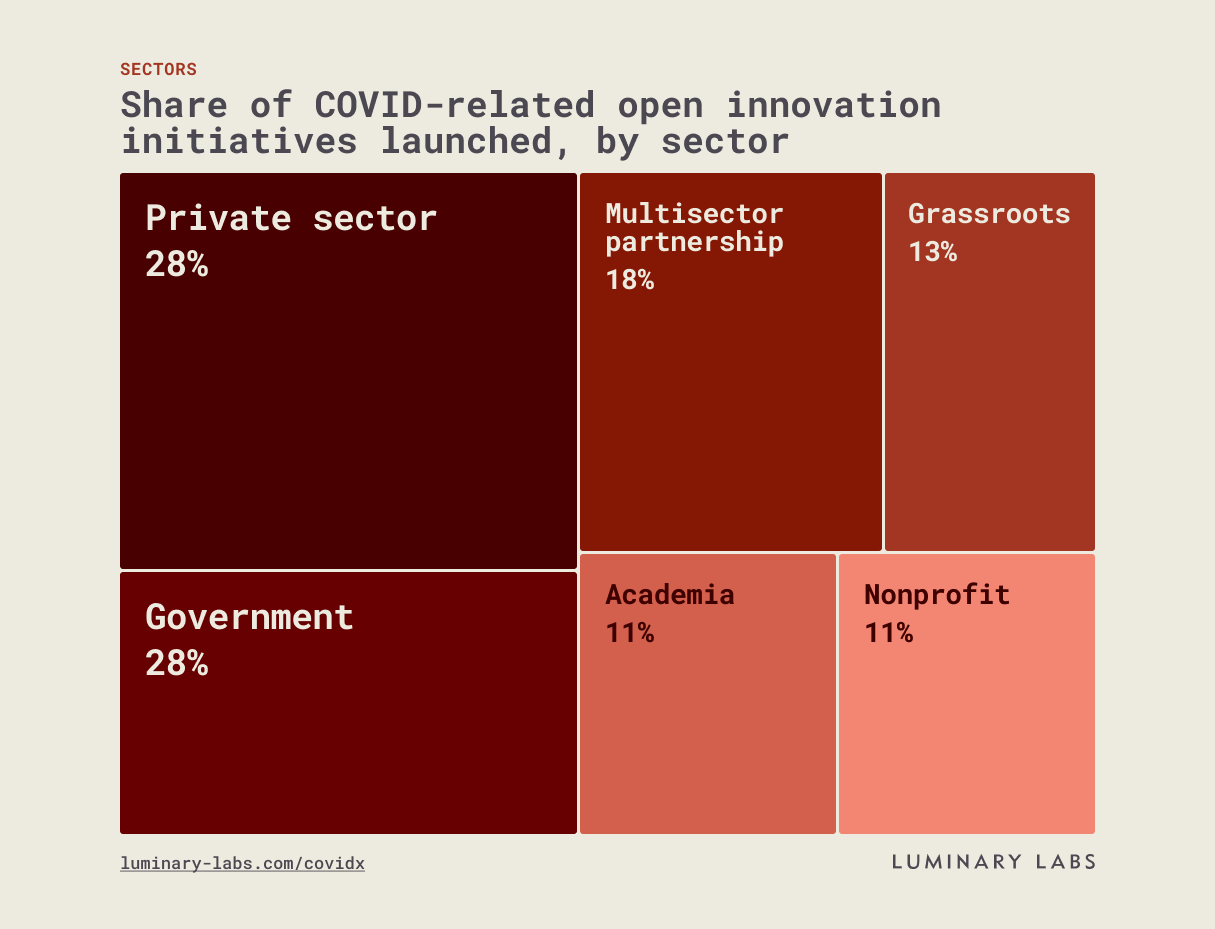
Source: Luminary Labs, CovidX Open Innovation Index sectors, 2020. (n=336 initiatives) For definitions, see “background and methodology” below.
While a range of established organizations launched OI initiatives, many groups self-organized without the direction or backing of large institutions. In the U.S., many people were staying at home in March and April 2020; some had time on their hands and wanted to volunteer and contribute to open innovation initiatives. More than one in 10 initiatives were grassroots or community-led; those initiatives peaked in March 2020 and quickly tapered off. Private sector launches also spiked in March. Government and multisector partnership launches were highest in April 2020.
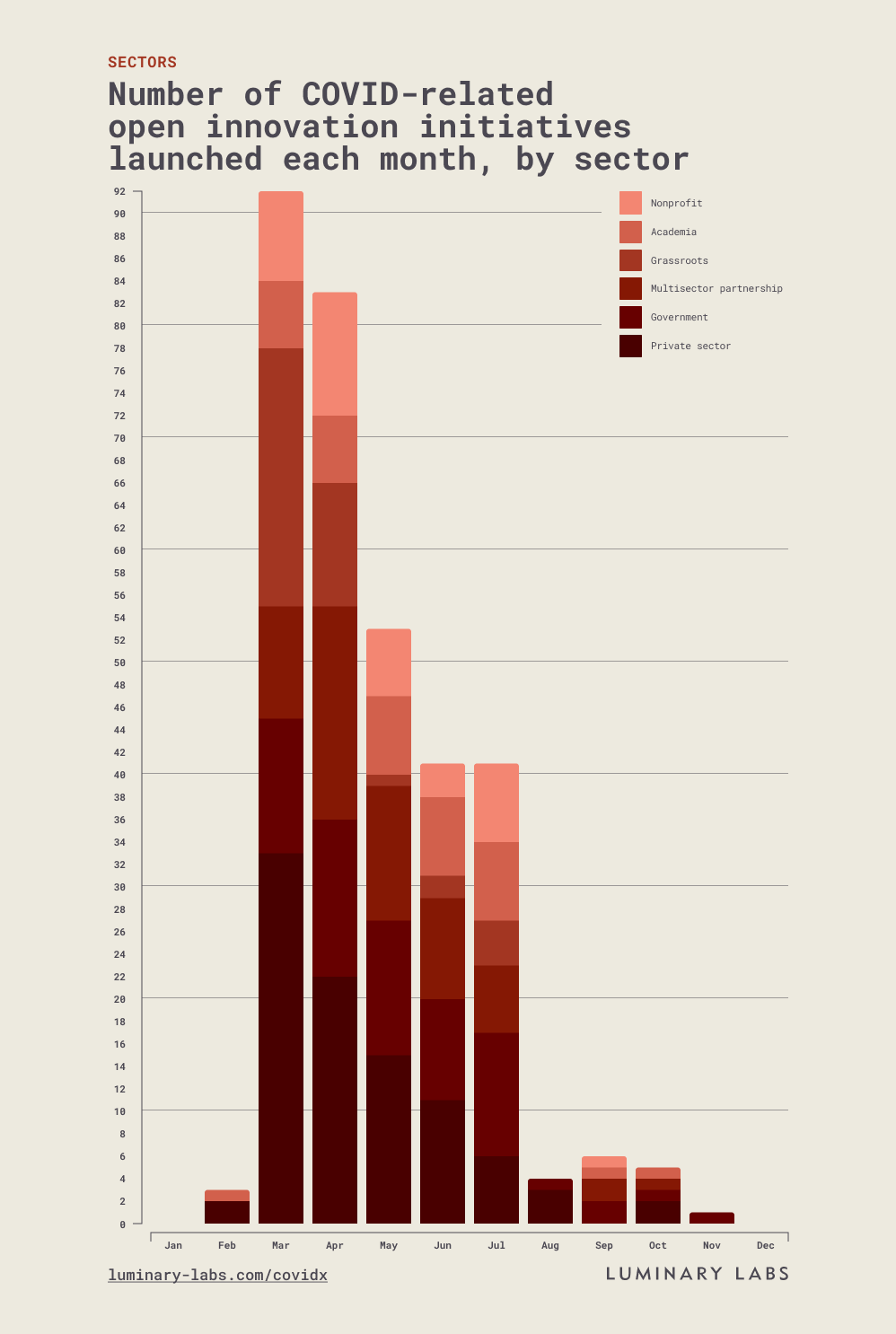
Source: Luminary Labs, CovidX Open Innovation Index sectors and launch dates, 2020. (n=329 initiatives) For definitions, see “background and methodology” below.
Organizations embraced the elasticity of OI, launching a broad range of initiatives in response to the pandemic.
When a problem is enormous and urgent, no single initiative or activity will be enough to solve it. To tackle the multifaceted problems of the pandemic, we needed different types of initiatives. Challenges and competitions and open data, open research, and information sharing were top categories, but no single type of open innovation represented more than one-quarter of OI index initiatives.
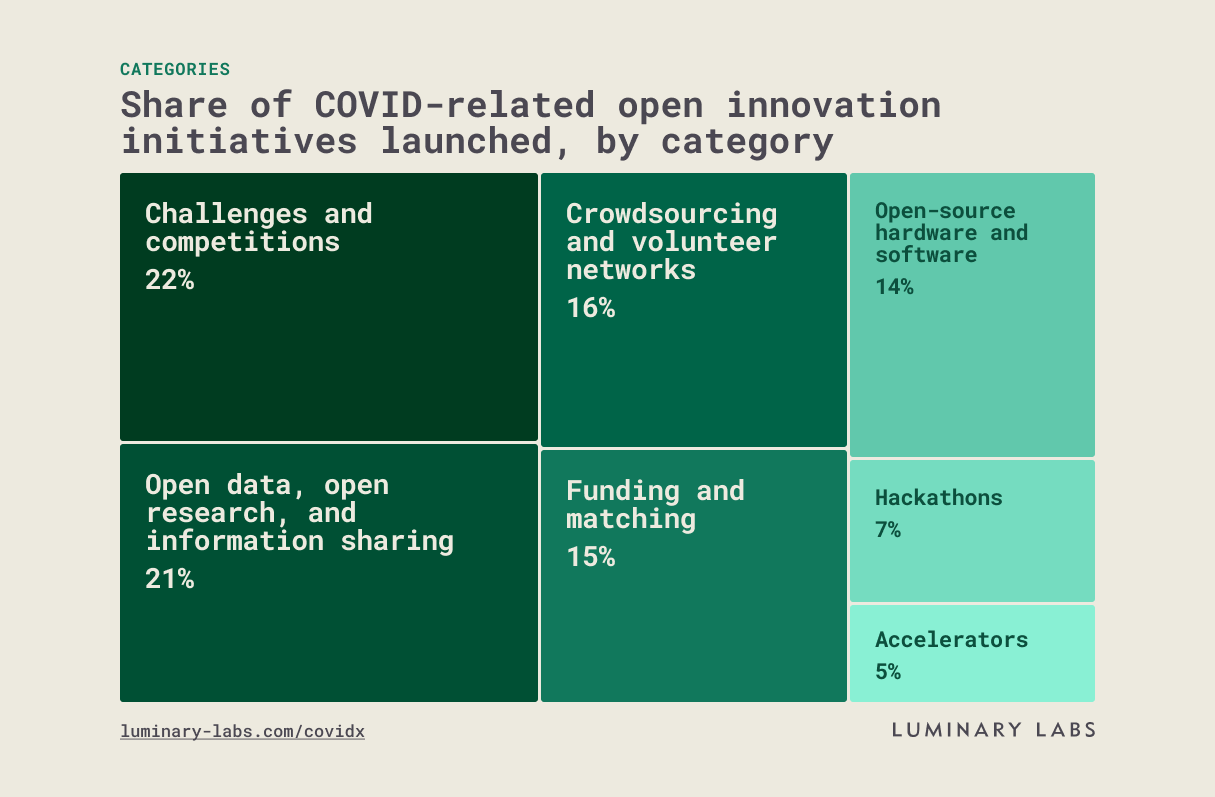
Source: Luminary Labs, CovidX Open Innovation Index categories, 2020. (n=336 initiatives) For definitions, see “background and methodology” below.
Funding and matching initiatives — from grant mechanisms to facilitated connections between funders and innovators — peaked early. Funders and philanthropists wanted to distribute money quickly, and they did: Of 51 funding and matching initiatives, 17 launched in March 2020 and 14 in April 2020. In a time of crisis, most rapid-response teams didn’t have time to establish nonprofit status — let alone complete a grant application or expenditure responsibility form. Not all philanthropies had rules that would flex around making grants to individuals or new grassroots initiatives, but some organizations considered help from fiscal sponsors or new funding mechanisms to make the money flow.
Many challenges and competitions launched in March and April 2020, but these launches peaked in May 2020 and far outnumbered other types of initiatives in May. Challenges and competitions — competitive, time-constrained initiatives that offer some form of incentive — are often larger and more complex than other types of open innovation initiatives; it takes some time to design a program.
The OI index tracked the highest numbers of open data, open research, and information sharing initiative launches in March and April 2020. From the beginning, the U.S. government had no centralized database for testing data, and open innovation initiatives popped up to fill the void. Some data projects and dashboards — perhaps most notably, Covid Tracking Project and Covid Act Now — have now been running for nearly a year.
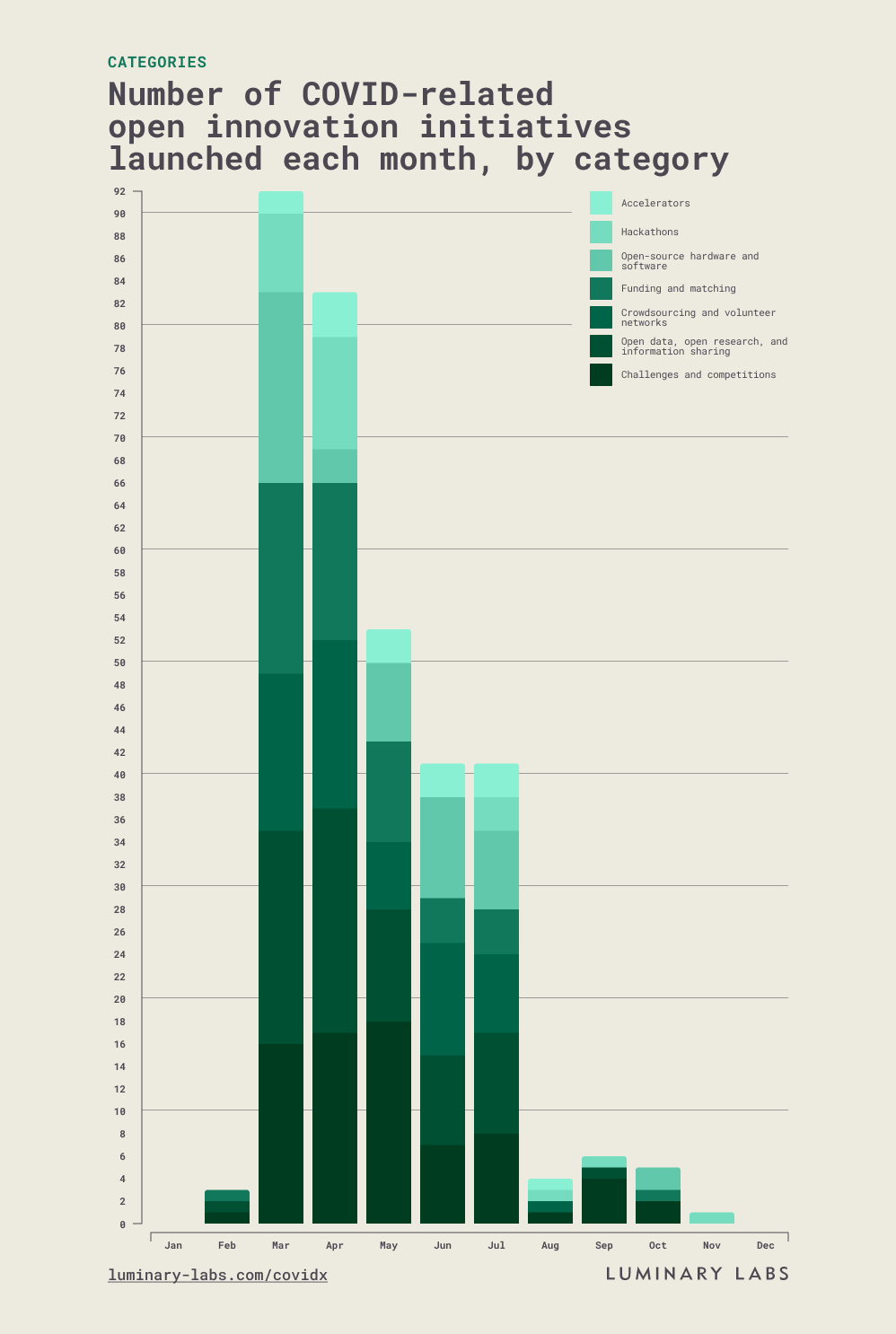
Source: Luminary Labs, CovidX Open Innovation Index categories and launch dates, 2020. (n=329 initiatives) For definitions, see “background and methodology” below.
In some cases, the open innovation categories aligned with the types of incentives offered to participants. Many open data, open-source hardware, and crowdsourcing initiatives offered only non-monetary or altruistic incentives. As expected, challenges and competitions and funding and matching initiatives often promoted monetary incentives. The majority of OI index initiatives (68%) did not publicize monetary incentives.
Early initiatives lacked specific problem statements, but focus areas and topics narrowed over time.
Many initiatives didn’t define a specific problem to solve — especially at first. A number of initiatives wanted to “hack the pandemic,” but didn’t have a clear focus or a defined problem statement. Of all the initiatives we tracked, only 40% specified a single focus area such as medical equipment, testing, PPE, economic support, or data-informed decision-making. The majority of initiatives named multiple problems to be solved or didn’t specify a problem at all (beyond COVID-19, broadly).
March and April 2020 saw the highest number of initiatives launch with an undefined focus area. The lack of clear problem statements and an emphasis on idea generation were understandable at first. But once the coronavirus and its impacts were better understood, open innovation initiatives needed to clearly articulate a specific problem if they expected to yield deployable solutions.
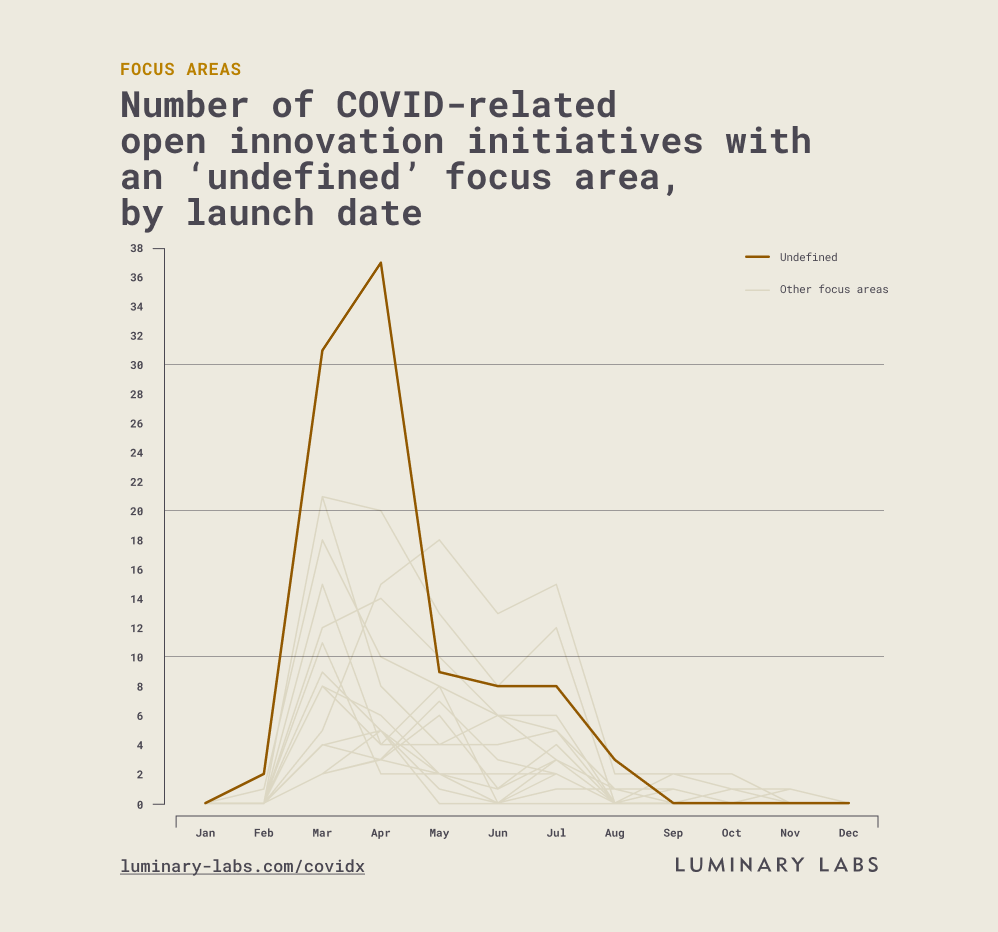
Source: Luminary Labs, CovidX Open Innovation Index focus areas and launch dates, 2020. (n=329 initiatives with one or more focus areas, including an “undefined” focus area) For definitions, see “background and methodology” below.
Early on, initiatives that did specify focus areas included rapid-response teams self-organizing to look for immediate medical (ventilator hacks, open-source PPE designs) and public health (testing data, tracing apps) solutions. By May 2020, more new initiatives were focusing on longer-term solutions to indirect social and economic problems (business recovery, mental health, education, supply chain).
As the pandemic’s secondary impacts revealed the areas of greatest need, initiatives focusing on economic support peaked in May 2020, and that remained the top focus area through June and July. The focus on recovery, resilience, and preparedness created opportunities for programs with longer time horizons and larger investments in design and awards.
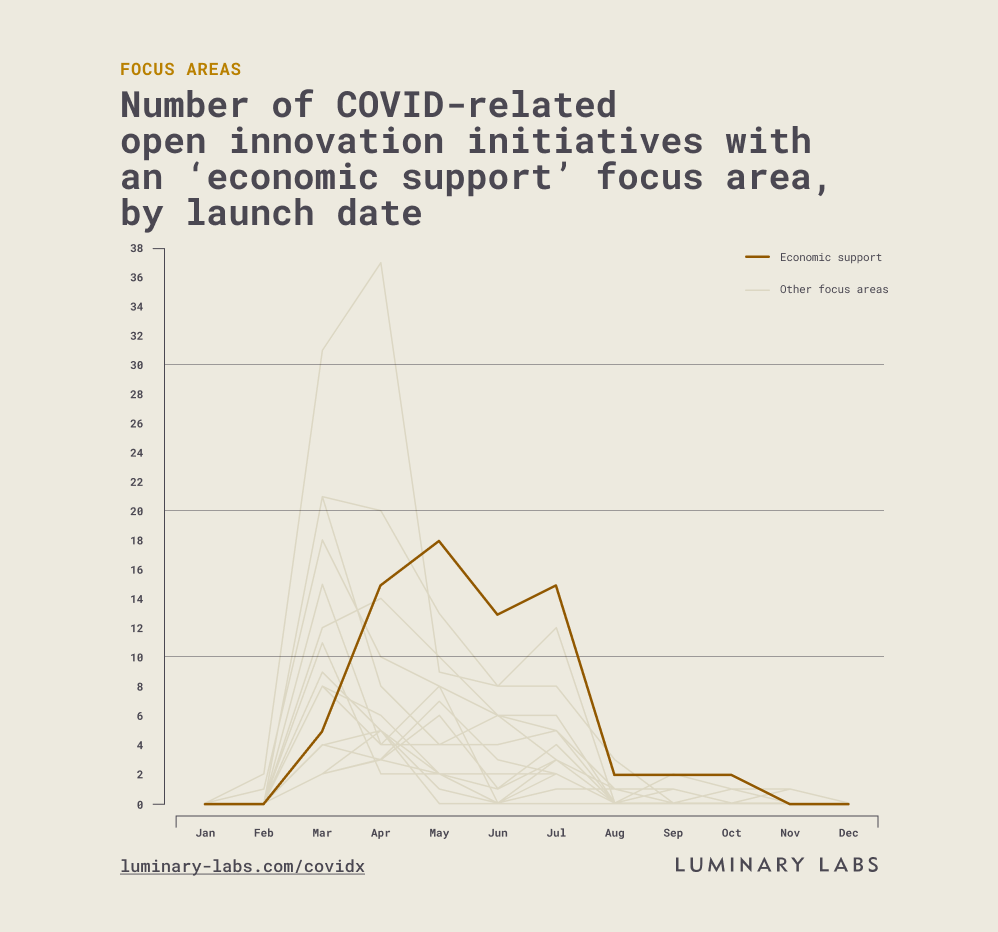
Source: Luminary Labs, CovidX Open Innovation Index focus areas and launch dates, 2020. (n=329 initiatives with one or more focus areas, including an “undefined” focus area) For definitions, see “background and methodology” below.
Overall, many initiatives that specified single or multiple focus areas focused on economic support, data-informed decision-making, and scientific discovery.
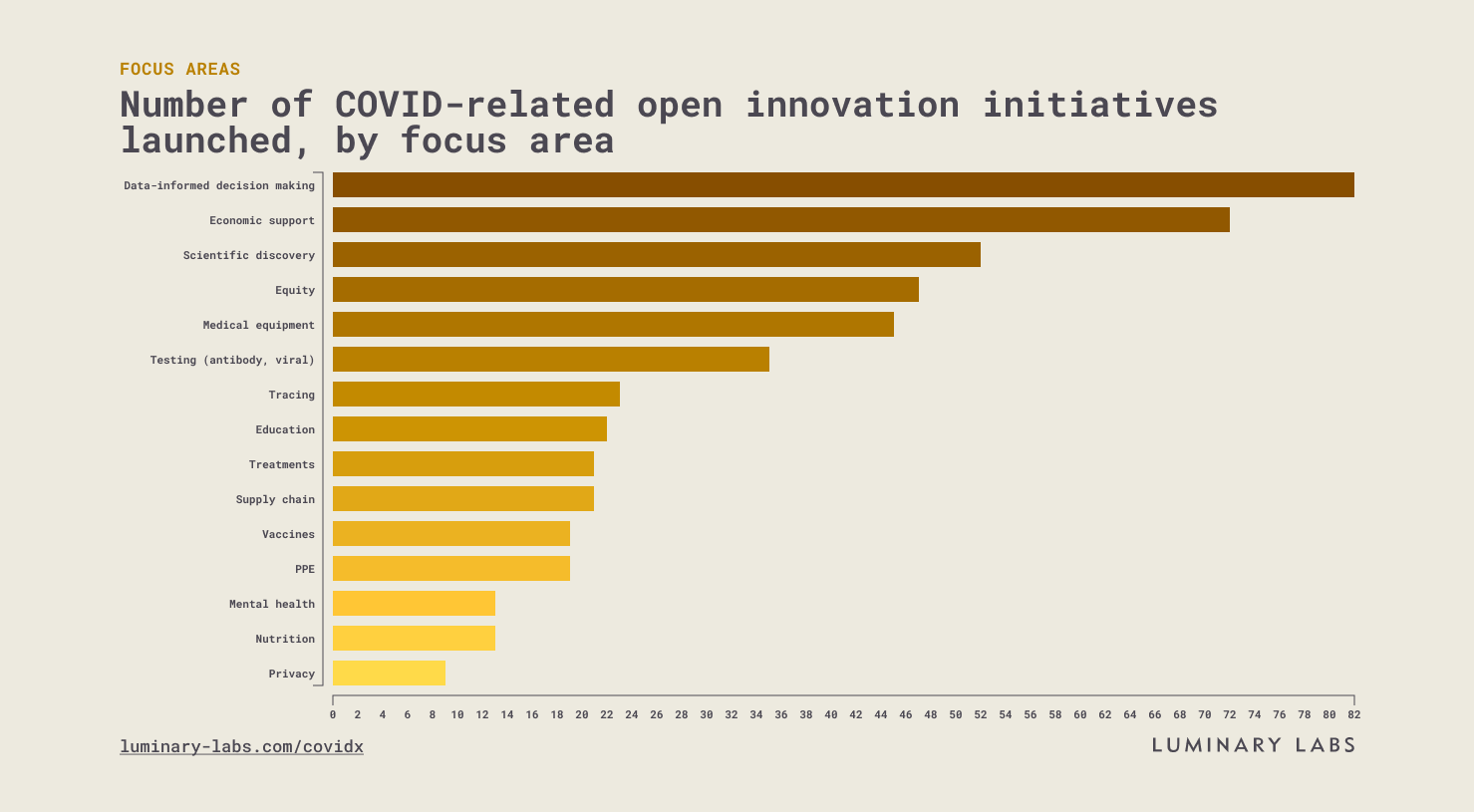
Source: Luminary Labs, CovidX Open Innovation Index focus areas, 2020. (n=336 initiatives with one or more focus areas, excluding an “undefined” focus area) For definitions, see “background and methodology” below.
What worked — and why it matters
Through our analysis, we identified exemplars of what worked. Initiatives that demonstrated early, positive outcomes had clear problem statements — in line with current needs at specific moments during the pandemic. They selected the right approach and the right people for the task at hand, building support and momentum with larger networks and communities.
Identify the right problem and gather the right people to tackle it.
No analysis of COVID-related open innovation initiatives would be complete without a mention of the Covid Tracking Project. This grassroots effort — founded by The Atlantic’s Alexis Madrigal and Robinson Meyer, in collaboration with content strategist Erin Kissane and Related Science founder Jeff Hammerbacher — now boasts an impressive list of team leads, contributors, funders, advisory board members, and software and data repositories. These “data heroes” filled a critical gap in government data, and the project’s data has become a critical source of information; the initiative has helped fuel the Atlantic’s exceptional coverage of the crisis and has supported many other dashboards and models, including Covid Act Now. Major media outlets, including the New York Times, have also used the project’s hospitalization and testing data. The team recently announced that they plan to release a final daily update and cease data compilation on March 7, 2021, the Covid Tracking Project’s one-year anniversary: “Although substantial gaps and complexities remain, we have seen persuasive evidence that the CDC and HHS are now both able and willing to take on the country’s massive deficits in public health data infrastructure, and to offer the best available data and science communication in the interim.”
Covid Act Now filled a similar gap, launching in March 2020 as a regional impact projection tool with an open-source model. A group of multidisciplinary volunteers with expertise in technology, design, data science, epidemiology, public health, and policy created CAN to help local leaders make informed decisions about responding to the pandemic. In the absence of localized and specific federal guidance, CAN has helped state officials, local communities, and individuals make decisions based on trusted data. CAN was created by a team of data scientists, engineers, and designers in partnership with epidemiologists, public health officials, and political leaders. After months of collaboration, CAN joined forces with Covid Exit Strategy, another key dashboard, in December 2020; Covid Exit Strategy was started by a group of public health and crisis experts with federal government experience. Covid Explained — a team of researchers and science students at Brown, Harvard, Massachusetts General Hospital, and MIT — joined CAN in January 2021 to “translate complex scientific concepts into simple, actionable, and research-driven explainers.”
The Covid Tracking Project and Covid Act Now both identified specific problems — gaps in data collection, analysis, and modeling — and quickly assembled a team of experts who could help fill those gaps. And as the initiatives grew, they continued to rally contributors, funders, and partners around common goals. A well-defined problem statement can help grassroots efforts and new upstarts make the best use of limited time and resources, producing better outcomes in a shorter period of time. But knowing the problem isn’t enough; finding the right expertise to solve it is just as important.
Collaborate and consolidate for efficiency and impact.
The first few months of the pandemic spurred grassroots efforts, local mutual aid initiatives, and community-centered responses. Some of these smaller upstart initiatives consolidated early on. For example, PPE donation and distribution networks — many of which launched as localized Google forms and spreadsheets in early March 2020 — quickly coalesced around initiatives with the strongest tools, branding, and coordination. Within a few weeks, 20 organizations and doers agreed to merge databases under the doctor-led Get Us PPE. A few days later, the fledgling organization received a grant from a group of funders led by Rock Health founder Halle Tecco. Get Us PPE developed a privacy-protected request form and a donation intake form — as well as a fair distribution algorithm that prioritizes help for those with the greatest need. To date, Get Us PPE has received over 20,845 requests for PPE and delivered more than 7.3 million pieces of PPE to frontline workers.
While other organizations continue to source PPE for frontline workers, Get Us PPE goes a step further. In addition to coordinating resources for those who want to request, donate, or make PPE, the organization is continuously tracking shortages. Get Us PPE’s PPE Shortage Index uses its database — the largest non-governmental database of PPE shortages in the United States — to quantify the persisting need. Since it operates only with donations, Get Us PPE partners with Project N95, another PPE-focused upstart that matches hospitals with suppliers.
Get Us PPE’s proclivity for collaboration has helped enable its success. The initiative began with an emphasis on cooperation and generosity — doctors came together to request and coordinate PPE donations in support of their colleagues. Instead of competing against similar initiatives, they quickly joined forces. As a result, the initiative gained exponential momentum and maximized its impact.
Adapt existing infrastructure to accelerate funding and identify solutions.
On April 1, 2020, NASA launched an agency-wide call for ideas through NASA @ WORK, its internal crowdsourcing platform. Employees were encouraged to submit novel approaches to PPE, ventilators, forecasting COVID’s spread, and other ideas relevant to NASA’s mission. In just two weeks, NASA employees submitted 250 ideas, made 500 comments, and cast more than 4,500 votes. In a media briefing on April 23, the agency announced several promising solutions, including a new high-pressure ventilator tailored specifically to treat COVID-19 patients. The ventilator, designed by engineers at NASA’s Jet Propulsion Laboratory in California, passed a critical test at the Icahn School of Medicine at Mount Sinai in New York; by April 30, the FDA had authorized the ventilator for emergency use.
Slow-moving grant funding processes are ill-equipped to respond to a rapidly evolving crisis. But Fast Grants from Emergent Ventures, a George Mason University Mercatus Center program, promised rapid funding decisions because “science funding mechanisms are too slow in normal times and may be much too slow during the COVID-19 pandemic.” Foundations and individual funders — Chan Zuckerberg Initiative, Schmidt Futures, Jack Dorsey, Reid Hoffman, Elon Musk, Chris Sacca, and other big names in tech — pledged over $40 million for grants to principal investigators at academic institutions. Fast Grants awarded 130 grants during its first call for applications, which launched on April 7, 2020, and promised funding decisions within 48 hours. Its second call promised funding decisions within two weeks — still much faster than most funding mechanisms. As of August 15, 2020, the initiative had awarded a total of 176 grants, ranging from $10,000 to $500,000 per award.
NASA @ WORK used its existing platform to source solutions to a new problem, and Fast Grants built on Emergent Ventures’ infrastructure and network. When rapid response is a priority, it’s often easier to repurpose existing open innovation infrastructure to tackle a new topic than to launch an entirely new program on short notice.
Demonstrate what’s possible, then refine and optimize.
The Metropolitan Transit Authority and Transit Innovation Partnership’s COVID-19 Response Challenge launched on July 8, 2020, with a call for “technologies to make public transit safer, cleaner, and more adaptive.” Submissions closed on August 19, and finalists presented solutions in an online showcase on September 18. In late October, the challenge selected eight companies from nearly 200 global applicants to work with the MTA, NJ Transit, and the Port Authority of New York and New Jersey on proofs of concept. Solutions range from micromobility and improved air filtration to new cleaning solutions and real-time crowd data. Pilots were set to begin on February 8, 2021.
The COVID-19 Response Challenge started with a specific problem — helping public transit adapt to the “new normal” of the pandemic — and yielded a range of potential technology solutions. By offering public demonstrations of possibility and connecting solvers with support at different phases of the multistage challenge, the initiative has been able to shepherd solutions toward viability. Early proofs of concept, rapid testing, and informed iteration can help open innovation initiatives produce strong results in a short period of time.
About Luminary Labs
Over the past decade, Luminary Labs has designed and produced large-scale open innovation programs that seek viable solutions to complex and pressing problems on behalf of federal agencies, nonprofit foundations, and the private sector. In 2018, Luminary Labs surveyed nearly 100 open innovation leaders to publish the inaugural State of Open Innovation report.
Acknowledgements
CovidX was a Luminary Labs initiative partially funded by Schmidt Futures. Betty Chang and David Adler supported OI index data collection and analysis.
Background and methodology
Luminary Labs began tracking coronavirus-related open innovation program launches — from hackathons and crowdsourced volunteer efforts to accelerators and competitions — in late February 2020. We shared an initial list of 27 initiatives with email subscribers on March 18, and one week later, the list had grown to more than 60 initiatives from around the world.
At the same time, Luminary Labs launched CovidX with funding from Schmidt Futures; the initiative aimed to identify opportunities for the government, private sector, and nonprofits to accelerate meaningful innovation and build a more resilient future. New additions to the open innovation index were published daily in the CovidX Digest. By May 21, 2020, the OI index was tracking more than 200 open innovation initiatives, and by the time we closed public submissions to the CovidX OI index at the end of July, the list had reached more than 310 initiatives.
The CovidX OI index didn’t only keep a running tally of rapid-response open innovation initiatives. This five-month inventory tracked each initiative’s category, focus area, participation deadline, incentives, and geographic area. We began our analysis of the index in fall 2020, adding a small set of new initiatives — bringing the total index to 336 — and visiting each initiative’s website to verify existing data and collect additional information.
How we define “sector.”
- Private sector. Businesses and corporate entities of any size.
- Government. Public-sector agencies; local or regional municipalities; regions, provinces, or states; and countries.
- Multisector partnership. Multiple organizations from different sectors.
- Grassroots. Community groups, volunteer organizations, and participant-led response teams.
- Academia. Educational institutions at any level.
- Nonprofit. Non-governmental organizations of any size, including foundations.
The sector variable is exclusive; an initiative has only one sector.
How we define “launch date.”
“Launch date” refers to the month of an initiative’s first announcement or the start of an open submissions period. If a specific launch date was unavailable or unclear on an initiative’s website, we used the date the initiative was first mentioned in the CovidX Digest. We were unable to verify launch dates for seven of the 336 initiatives in the OI index.
How we define “category.”
- Accelerators. A cohort-based (and often fixed-term) initiative to accelerate progression of solutions.
- Challenges and competitions. A competitive, time-constrained initiative that offers some form of incentive.
- Crowdsourcing and volunteer networks. An initiative that collects and shares talent, expertise, or solutions.
- Funding and matching. An initiative that offers funding or non-monetary benefits (for example, mentorship, technical assistance, or jobs), including facilitation of connections between innovators and funders.
- Hackathons. A synchronous event for collaborative problem solving.
- Open data, open research, and information sharing. A dataset that is freely available (via API, database, repositories, etc.) for people to use and build upon.
- Open-source hardware and software. A product or service that is made freely and openly available, and may be distributed or modified.
The category variable is exclusive; an initiative has only one category.
How we define “incentive.”
- Monetary. Prizes or funding.
- Non-monetary. Support in the form of mentorship, learning, technical assistance, connections, or other expertise.
- Community service. Emphasizing community service, volunteerism, and belonging as a reason to participate. (Any initiative with unspecified or unclear incentives was tagged with “community service,” assuming that all COVID-related initiatives rely on some level of altruistic incentive to engage solvers.)
The incentive variable is non-exclusive; an initiative may have more than one incentive.
How we define “focus area.”
- Undefined. No clearly defined focus area. Includes all initiatives with broad “or other problems related to COVID-19” statements.
- Data-informed decision-making. Help policymakers, business leaders, citizens, and other decision makers take reasoned actions based on data.
- Tracing. Identification, notification, and follow-up with a person who may have been exposed to an infected person.
- Testing (antibody, viral). Development and availability of fast, accurate tests to identify exposure to the coronavirus.
- Scientific discovery. Research in a wide range of scientific fields (for example, biology, chemistry, or pharmacology) to develop new medical treatments or procedures for COVID-19.
- Medical equipment (including ventilators). Tools used by healthcare workers and other emergency professionals to treat COVID-19 patients safely.
- Personal Protective Equipment (PPE). Equipment worn to minimize exposure to hazards related to COVID-19.
- Vaccines. Research and development of a biological preparation providing active acquired immunity to COVID-19.
- Treatments. Management and care of a COVID-19 patient.
- Supply chain. Systemic production and distribution logistics of goods and services.
- Privacy. Protection from unauthorized intrusion on privacy rights.
- Equity. Support of at-risk populations that are particularly vulnerable to COVID-19 (e.g., homeless, incarcerated, low-income populations).
- Nutrition. The process of providing or obtaining food necessary for health and growth.
- Economic support. Business and/or workforce support, including creating and preserving jobs, unemployment support, and economic assistance for small businesses.
- Education. Support for disrupted K-12 or university teaching and learning.
- Mental health. Care and support for psychological and emotional well-being during COVID-19.
The focus area variable is non-exclusive; an initiative may have more than one focus area.



